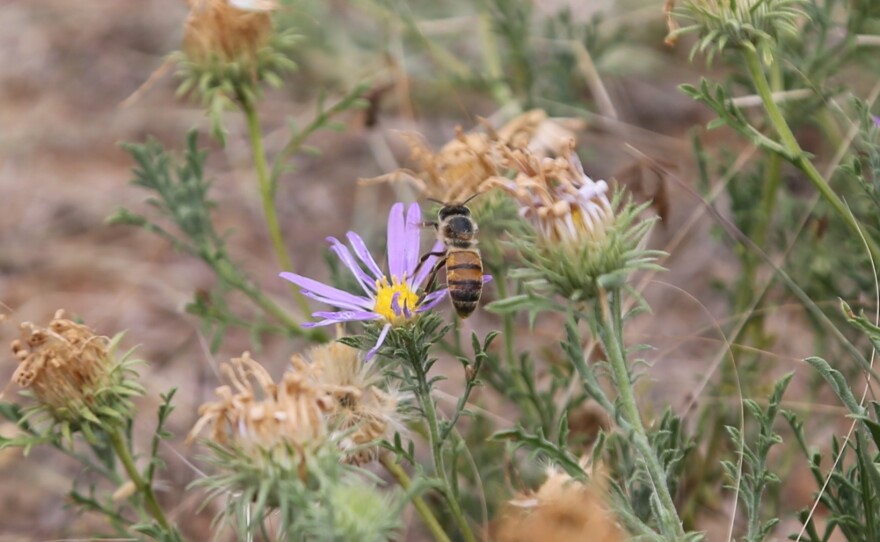The South Plains might be known for prairie dogs, cows, and cotton, but there’s a lot more unique wildlife in the region than one might expect. As plant life sustains animals and our local economy, those plants are sustained by their pollinators.
Dr. Scott Longing is an associate professor of Plant and Soil Science and entomology at Texas Tech University.
The Entomology Lab at Tech researches plant-pollinator networks in grassland ecosystems, including the bristly nama, which grows in the southwestern United States and into Mexico.
Until 2017, Longing didn’t know much about the bristly nama and its specialist bees.
The Sphecodosoma pratti is a kind of short-faced sweat bee. They only forage on nama plants and they nest in the ground nearby.
In a field outside of the TTU Innovation Hub, Longing pointed out female bees collecting pollen and male bees, who “divebomb” them.
“The males are less interested in the nectar, more interested in the females,” he said.
These bees need the nama plant and while other pollinators – like honeybees and butterflies – may visit the bristly nama for nectar, they don’t transfer pollen as efficiently as the specialist bees.
Texas has about 1,200-1,300 species of bees, and according to Longing, 25% of those are specialists.
He explained that when it comes to the bristly nama, “if you go to Southwestern Oklahoma or Arizona or California or Mexico, there's likely a different bee species specializing on it.”

Before his arrival at Texas Tech in 2012, Longing had done research in northeast Georgia, the Appalachian Highlands, the Ozark Mountains, and the Monahans Sandhills.
“And then these grasslands, these short grass prairies, they're fascinating,” he said. “It's not just for the sake of biodiversity, really anymore. It's understanding how they maintain plant communities and contribute to pollination and predation of our pest insects and decomposition and all these different things.”
About ten years ago, Longing began a partnership with Texas Parks & Wildlife, documenting the native bees in the region, in collaboration with the Natural Science Research Laboratory and its curator of invertebrate zoology Dr. Jennifer Girón.
Longing said the team is about halfway through digitizing its database of approximately 20,000 bee specimens to make it accessible.
He collects bees with an aspirator, what looks like a long tube and a metal straw attached to a little jar.
“You got to sneak up on them,” he said after catching one in a foraging frenzy. “But when they're like this, they're like male deer in December or November.”
Longing has been studying these specialist bees and the bristly nama since 2018.
Unlike honeybees – which have a caste system, colonies, and a queen – these are solitary bees. Each female collects her own pollen and takes care of the brood chambers underground.
In fact, most bee species are small and solitary like these ones.
“A lot of bees out here like this are working. I mean, they're maintaining plant communities and pollinating and just being busy like this, but just often never seen. And I did the same thing,” he said. “I knew it was a bee when I looked down. I didn't know what bee and even what plant. But that's when my world was open to small bees and specialization and all these cool questions about how that's co-evolved, and how it's maintained.”
Longing said many people don’t think much about the nama plant because they don’t know what it is, but it is all over the City of Lubbock. In areas like Mackenzie Park and the Canyon Lakes, but also in vacant lots, in the cracks of sidewalks, and along fence lines.
The bristly nama is resilient, but the ecosystem and the pollinators relying on it – less so. Within a 20-square-foot area, generations of nama and bees can be sustained. It is a biodiversity hub that hosts many different species. And if it’s mowed, it’s gone.
“So if we were, say, to charge people to recognize this and not mow it or not disturb it, kind of let it be. Then that, to me, that would be a shining example of how we can take care of the environment,” he said.
Longing encourages people to take an interest in their surroundings. Apps like iNaturalist allow people to identify plants and animals. And while folks can see nature all around them, he says the Lubbock Lake Landmark is a great place to see local flora – including nama – on a grander scale.
“I'm a little biased towards nature,” he admitted. “But, you know, I see it just for what it is, and as something that we should invest in, for future generations and for ourselves, for all these different types of ecosystem services that they provide, that nature provides.”










